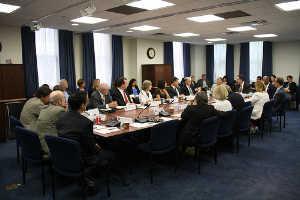EPA's Role in International Trade

Meeting of the Trade and Environment Policy Advisory Committee (TEPAC), June 2010. Official USTR photo.
Global trade presents economic and policy opportunities and challenges. EPA works with domestic and international partners to address policy challenges, reduce the environmental impacts, and maximize the benefits of trade for U.S. industry.
- EPA Role in the Trade Agreement Process
- North American Free Trade Agreement
- Trans-Pacific Partnership
- Trade and Environment Policy Advisory Committee
- Smartway
EPA Role in the Trade Agreement Process
Developing Environment-related Provisions in Proposed Trade Agreements
EPA works with the USTR and other government agencies to develop and review environment-related provisions of proposed trade agreements and build the capacity of U.S. trading partners to develop, implement, and enforce sound environmental standards.
By encouraging the implementation of such standards abroad, EPA and USTR aim to:
- minimize the domestic effects of cross-boundary pollutants, and
- ensure that U.S. industry has a level playing field on which to compete.
This includes reviewing and making decisions regarding the content and implementation of environmental elements of the agreements, including environmental chapters in the thirteen trade agreements featured to the right.
Implementing Trade Related Environmental Activities
EPA works with the State Department, trade partners and others to develop projects and programs that implement environmental capacity building activities provided for under trade agreements and can serve as the basis for environmental capacity building, technical assistance and knowledge sharing. These collaborative international efforts increase the effectiveness of U.S. trade agreements and create markets for environmental technology.
For more information on EPA-specific activities, please see the following links:
- NAFTA: The North American Commission on Environmental Cooperation (CEC)
- Capacity-Building Programs Under the Dominican Republic-Central America-United States Free Trade Agreement (CAFTA-DR)
- EPA Collaboration with Singapore
Reviewing Environmental Effects of Proposed Agreements
EPA works with USTR, the President's Council on Environmental Quality and other federal partners to review the effects on the domestic environment that could result from implementation of the agreement. Executive Order 13141 and its implementing guidelines provide the formal basis for conducting these reviews.
Learn more about:
- Environmental Reviews
- Executive Order 13141 (PDF) and its implementing guidelines (PDF)
In 1992, the North American Free Trade Agreement (NAFTA), a trade agreement between the US, Canada and Mexico, was finalized. This agreement created the largest free trade area in the world when it was signed. Today, EPA works with a number of institutions established by NAFTA and related agreements to address environmental issues in the North American region.
The North American Agreement on Environmental Cooperation (NAAEC), a side agreement to NAFTA, created a mechanism in which any non-governmental organization or person in any of the three countries can assert that one of the Parties (i.e., the United States, Canada, and Mexico) is failing to enforce its environmental laws.
In addition, the NAAEC established the Commission for Environmental Cooperation (CEC) to address regional environmental concerns, help prevent potential trade and environmental conflicts, promote the effective enforcement of environmental law, and to monitor the environmental effects of the NAFTA.
NAFTA also prompted the creation of the North American Development Bank (NADB) and its sister institution, the Border Environment Cooperation Commission (BECC).
Learn more about:
- North American Free Trade Agreement (NAFTA)
- North American Commission for Environmental Cooperation (CEC)
- EPA’s work with the BECC-NADB
The Trans-Pacific Partnership (TPP) is a proposed comprehensive free trade agreement for the Asia-Pacific region. Negotiations began in Melbourne on March 2010. EPA was a key member of the U.S. interagency team negotiating provisions of the TPP agreement.
The potential parties to the TPP include the United States, Australia, Brunei Darussalam, Canada, Chile, Japan, Malaysia, Mexico, New Zealand, Peru, Singapore and Vietnam. The TPP will expand an existing trade agreement between Brunei, Chile, New Zealand and Singapore.
- Learn more about the Trans-Pacific Partnership
Trade and Environment Policy Advisory Committee
The Trade and Environment Policy Advisory Committee (TEPAC) provides policy advice to the EPA and the Office of the U.S. Trade Representative on issues pertaining to the nexus between the environment and trade. TEPAC is comprised of representatives of non-profit and private sector organizations.
Co-hosted by the U.S. Trade Representative and the EPA Administrator, TEPAC meets twice a year. Members are briefed on environment and trade related issues and can provide input and guidance to the Administration and members of Congress. EPA uses this forum to update, and receive feedback from, TEPAC members on environmental issues of importance.
- Learn more about the Trade and Environment Policy Advisory Committee (TEPAC)
Smartway
SmartWay is a public/private collaboration between the USEPA and the freight transportation industry that helps freight shippers, carriers, and logistics companies improve fuel-efficiency to save money and increase profits.
EPA's SmartWay International program works with international stakeholders to help countries develop their own freight sustainability programs. The issue is vital due to the increasing connectivity of the global economy through global supply chain, creating concerns about energy security, economic vitality and climate change from transportation.
Learn more about:
Contacts
For additional information on EPA's trade programs, contact:
Joe Ferrante
U.S. Environmental Protection Agency
Office of International and Tribal Affairs (2670R)
1200 Pennsylvania Ave., NW
Washington, DC 20460
E-mail: ferrante.joe@epa.gov
